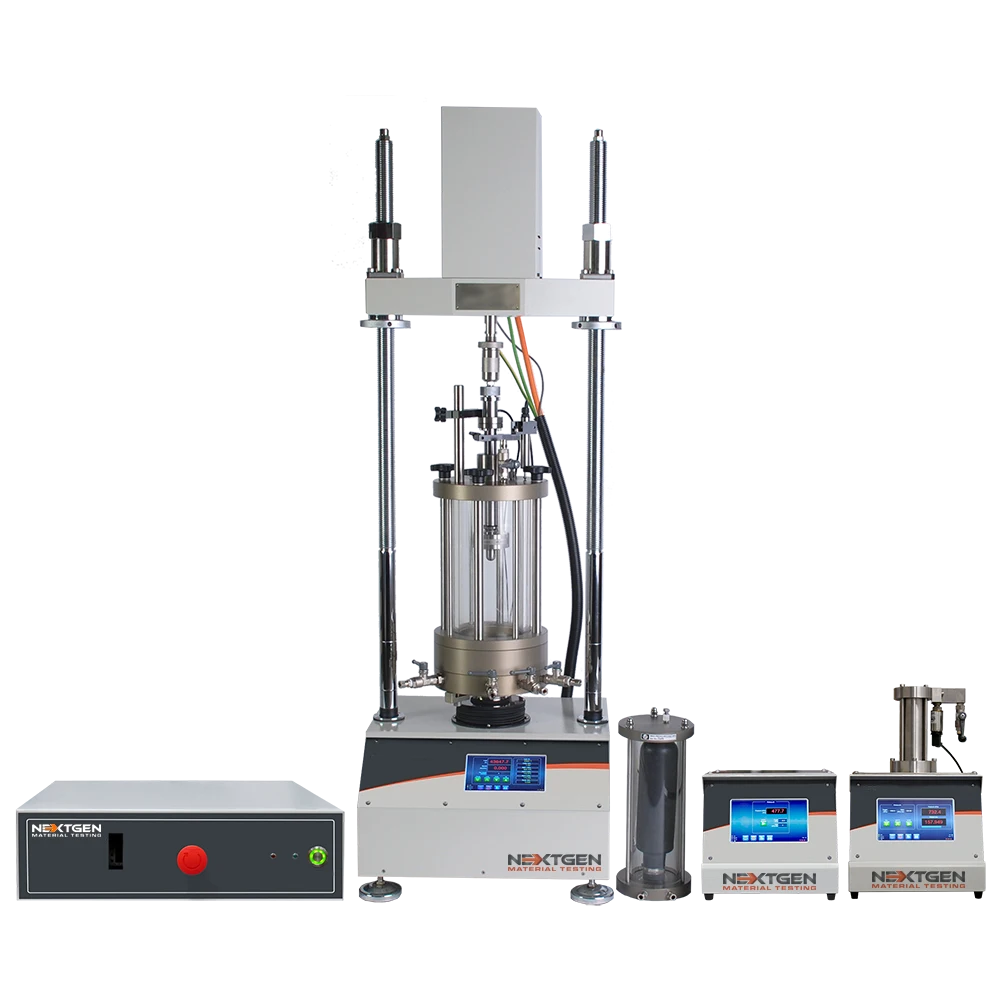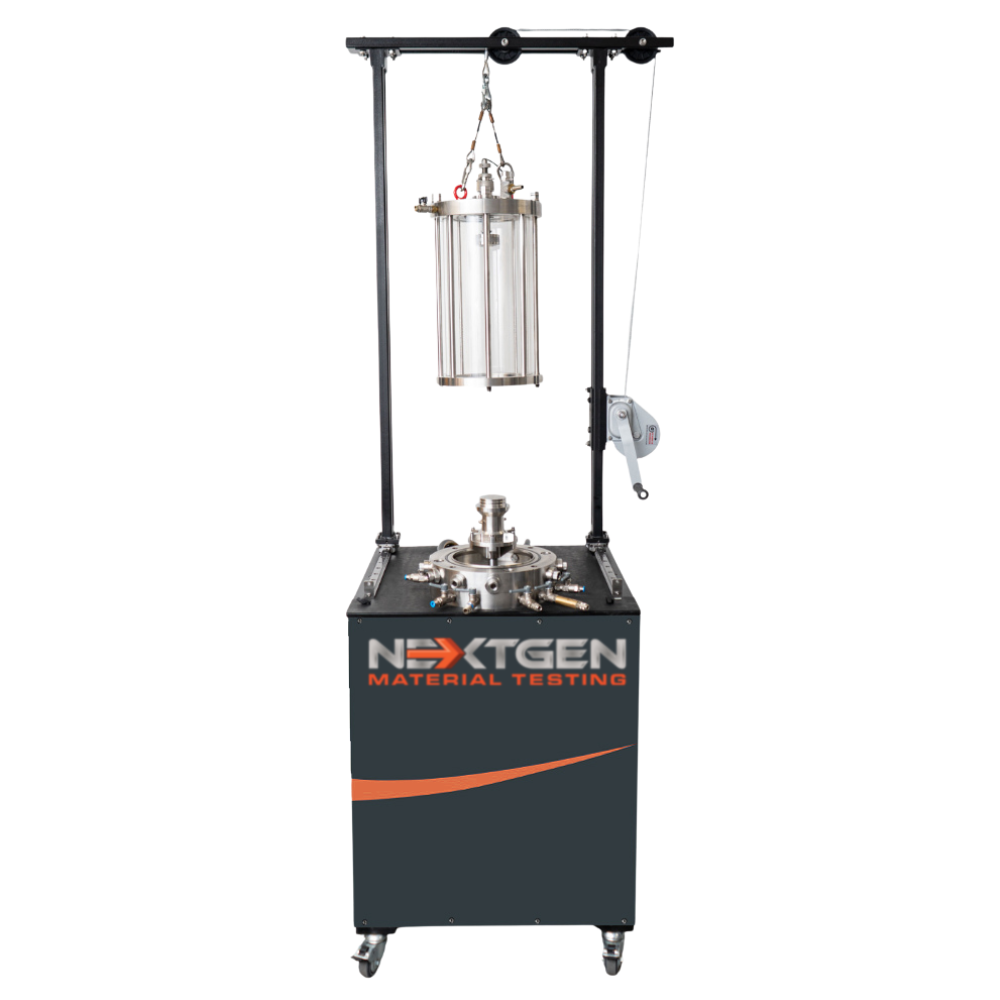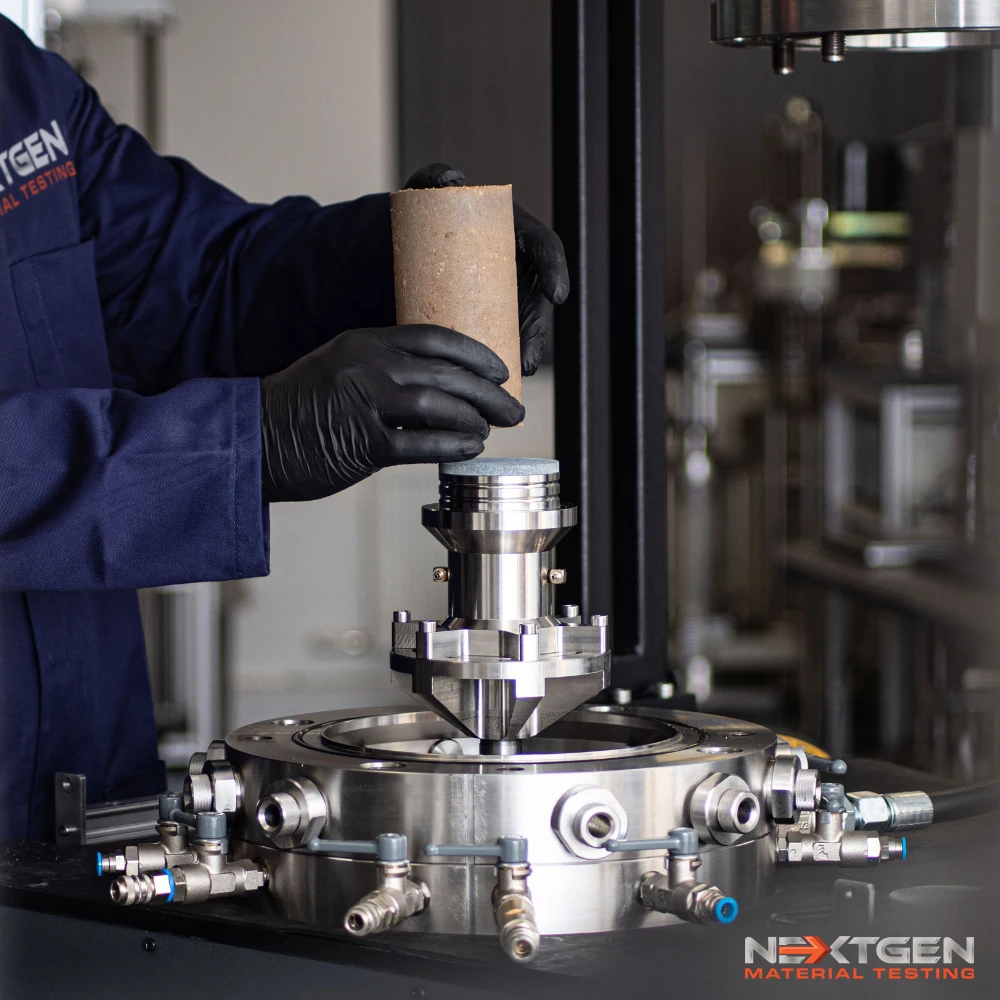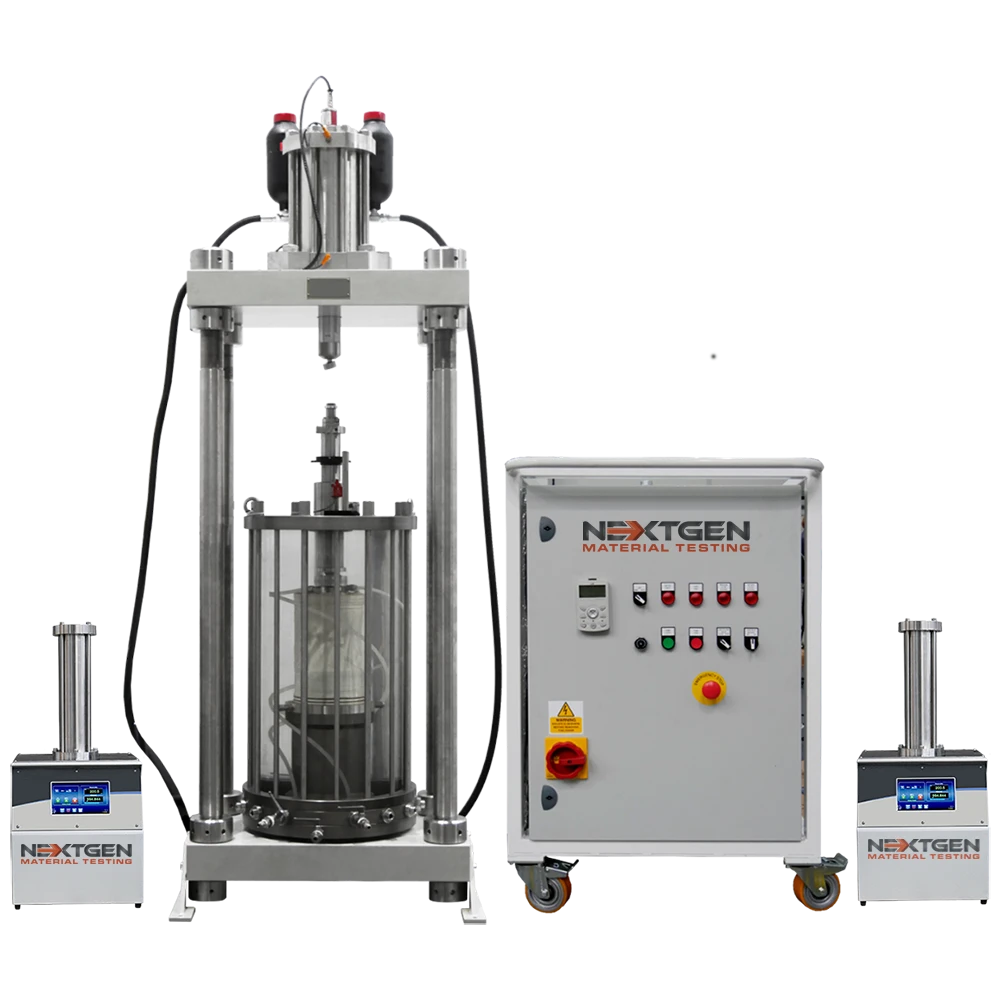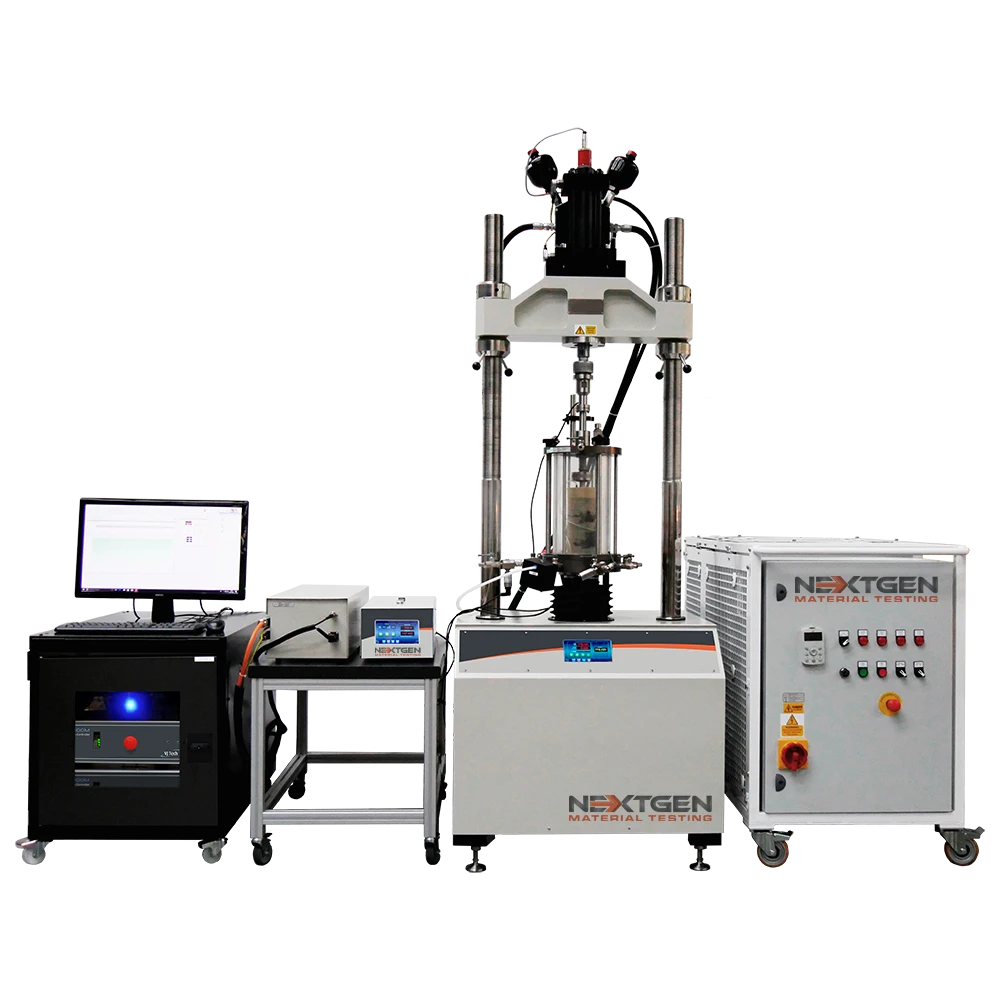Soil Mechanics Testing Equipment
Standards






Description
NextGen offers a variety of Dynamic Triaxial Systems, with capacities ranging from 5kN/5Hz to 50kN/20Hz, designed to meet your specific testing requirements. Whether you're testing small or large specimens, using Bender Elements, or on-sample local strain sensors, our Dynamic Triaxial Systems can be configured to match your needs. The system features a Dynamic Servo Controller that supports up to 8 input channels and various waveforms. It includes adaptive PID control, allowing the system to automatically adjust internal settings to ensure target load and displacement are achieved, even as sample stiffness changes during the test. This ensures consistent, accurate results for dynamic soil testing.
Standard system configurations feature Pressure Volume Controllers for precise Back Pressure and Cell Pressure control. For enhanced cell pressure regulation or dynamic cycling of lateral pressure around the sample, an upgraded Dynamic Cell Pressure Controller is available.
The Clisp Studio software simplifies the entire testing process, covering everything from Saturation to various Consolidation phases (Isotropic, Anisotropic, or K0), Static Loading, Stress Path, and Cyclic Shear (Stress or Strain) tests. With its intuitive interface, Clisp Studio ensures easy setup and efficient execution, streamlining even the most complex geotechnical testing procedures.
Dynamic Triaxial System Features
- Dynamic or Hydraulic Servo Controller supports up to 8 input channels for sensor integration.
- Closed loop control for precise and consistent testing operations.
- Built-in signal conditioning to enhance data accuracy.
- Supports a variety of waveforms, including Sinusoidal, Square, Triangular, Haversine, Saw Tooth, Inverted Saw Tooth, Rectangular, and User Defined waveforms.
- Adaptive PID control (Peak and Trough Control) adjusts automatically during testing for optimal performance.
- USB or Ethernet connectivity for seamless PC control.
- Data logging rate of 200 points per cycle or 500 points per second.
- Built-in auto engage function with a definable engage value for efficient setup.
- Auto reverse function triggered by limit switch activation for safety.
- Lower and upper limit switch motion control ensures operational boundaries are maintained.
Dynamic Triaxial System Technical Specifications
|
Model |
Dynamic Triaxial System |
|
Minimum Frequency (Hz) |
0.0001 |
|
Maximum Frequency (Hz) |
5, 10, 20 |
|
Dynamic Range (kN) |
5, 10, 20, 30, 50 |
|
Displacement Range |
+/- 35mm (70mm travel) |
|
Waveforms |
Sinusoidal, Square, Triangular, Haversine, Saw Tooth, Inverted Saw Tooth, Rectangular, User Defined |
|
Data Logging Rate |
200 Points/Cycle or 500 Points/Sec |
|
Sample Size Diameter (mm) |
35, 38, 50, 63.5, 70, 75, 100, 150, 300, 315 mm dia (Other sizes available upon request) |
Dynamic Triaxial System Accessories List
-
External Displacement Sensors: Available in various displacement ranges, common sizes (mm) are 10, 25, 50, 100.
-
External Load Cells: Used for standard UU, CIU, and CID tests. Available capacities (kN) are 5, 10, 20, and 50.
-
Internal Submersible Load Cells: Our Internal Submersible Load Cells are expertly pressure compensated and strategically positioned within the Triaxial Cell or Pressure Chamber, making them essential for advanced geotechnical testing. These load cells are specifically required for conducting Anisotropic/k0 Consolidation and Extension Tests, ensuring precise and reliable data. Available in a range of load capacities, including 5 kN, 10 kN, 25 kN, and 50 kN, these versatile load cells cater to various testing needs. Additional sizes can be provided upon request to meet the specific requirements of your geotechnical projects.
-
External Pressure Transducers: Used for PwP measurement. Require a De-airing Block.
-
Internal Pressure Transducers: Allows for mid-height PwP Measurement. The sensor is mounted directly on the Sample.
-
Transducer Access Ring: Upgrades your Triaxial Cell to acccommodate internal sensors, allowing the cables to exit the Chamber without leakage.
-
Top Cap & Base Pedestals (Triaxial): Our Top Caps and Base Pedestals are designed for versatility, available in a variety of sizes to ensure seamless interchangeability within your Triaxial Cell. The Top Caps are offered in multiple types to suit different testing requirements, including Domed (Compression only), Fixed (Compression and Extension), and Suction (Compression and Extension). This flexibility allows for precise and efficient adaptation to various geotechnical testing scenarios, enhancing the overall performance and reliability of your testing equipment.
-
Internal Submersible LVDT Kit (Triax): Includes one radial caliper, two axial brackets, and three LVDT sensors.
-
Bender Elements: Vertical and Horizontal positions.
-
De-aired water system: De-aired water tank (4.2 Gal / 19 liter capacity) availability in hard anodised or stainless steel for durability. Vacuum pump is required, ordered separately.
-
Automatic Solenoid Valve: The Solenoid Valve is a key component for achieving complete automation in your geotechnical testing processes. By automatically opening and closing valves, it eliminates the need for manual intervention, streamlining operations and enhancing efficiency. This automation is seamlessly managed through advanced software integration, ensuring precise control and reliability throughout your testing procedures.
-
APC Water & Air Distribution Panel: Our system assists users in efficiently filling and emptying Pressure Controllers, Triaxial Cells, and other pressure chambers. We offer a variety of panel sizes designed to connect multiple devices, providing flexibility and ease of use. These panels can be supplied with or without a mechanical pressure gauge, offering an independent reference point for enhanced accuracy and reliability in your geotechnical testing setup.
-
Porous Stones
-
Filter Paper
Value in the Market
The system enhances testing efficiency and accuracy, allowing laboratories and geotechnical firms to handle more sophisticated projects with confidence. Its versatility in waveform support and connectivity options, paired with automation and safety features, make it a valuable asset for improving productivity and ensuring high-quality results in construction, infrastructure, and research sectors. This positions such systems as essential tools for companies looking to stay competitive by delivering fast, accurate, and repeatable test results.
FAQs
The primary purpose of Dynamic Triaxial Systems is to facilitate advanced soil mechanics testing under varying pressure and load conditions, enabling accurate assessment of soil behavior in different scenarios. This system provides insights into soil stability, elasticity, and resistance by simulating the dynamic conditions soil samples would experience in real-world situations, such as during seismic activity or under heavy construction loads.
This system is particularly valuable for laboratories, geotechnical engineering firms, and research institutions involved in civil engineering and infrastructure projects. It allows for both static and dynamic testing, allowing it to be used for evaluating soil properties in both steady and changing stress environments. With adaptive control features, automated data logging, and customizable configurations, it supports detailed analysis across a range of test conditions.
Click here to learn more about the product or here to receive a personalized quote.
The Dynamic Triaxial Systems are designed to handle an array of specimen sizes and testing configurations, making them adaptable to different geotechnical testing requirements. Whether testing small or large specimens, the system offers flexibility to ensure accurate results. It supports specimens of different diameters, including common sizes such as 35 mm, 38 mm, 50 mm, and up to 315 mm, with options to customize further based on specific project needs.
Additionally, the system is compatible with several types of sensors, such as Bender Elements for seismic testing and on-sample local strain sensors for precise deformation measurements directly on the specimen. This adaptability makes Dynamic Triaxial Systems suitable for testing different soil types and conditions, from fine granular soils to coarse aggregates, under both static and dynamic loads.
Click here to learn more about the product or here to receive a personalized quote.
Yes, our Dynamic Triaxial Systems comply with ASTM D 5311 standards, which govern the methods for conducting triaxial compression tests on soil under consolidated and undrained conditions. This standard guarantees that soil samples are tested accurately and reliably, particularly in conditions where pore water pressure and total stress need to be closely monitored and controlled. Compliance with ASTM D 5311 is a necessity for conducting geotechnical analyses that simulate real-world soil behavior under different load conditions.
In compliance with ASTM D 5311, our Dynamic Triaxial Systems enable precise measurement of soil stability and strength characteristics, helping engineers and researchers understand how soils will react under stress, such as during earthquakes, construction, or heavy infrastructure loads. This standardization allows laboratories and engineering teams to produce accurate and comparable results across different projects.
Click here to learn more about the product or here to receive a personalized quote.
Dynamic Triaxial Systems by NextGen provides a broad selection of capacities customized to meet diverse testing requirements. The systems offer force capacities from 5 kN to 50 kN and frequencies ranging from 5 Hz to 20 Hz, making them adaptable to different soil testing applications. This range allows users to conduct both low-intensity tests on small specimens and high-intensity tests on larger samples or under conditions requiring greater force and frequency.
These customizable capacity options make Dynamic Triaxial Systems suitable for different geotechnical testing needs, whether for routine laboratory analysis or advanced soil behavior research under simulated seismic and load-bearing conditions. With such flexibility, these systems are valuable for professionals in construction, civil engineering, and infrastructure projects, enabling accurate insights into soil stability and performance under a range of dynamic stresses.
Click here to learn more about the product or here to receive a personalized quote.
Dynamic Triaxial Systems hold significant value in the market due to their ability to maximize testing efficiency and accuracy, allowing laboratories and geotechnical firms to undertake more complex projects with assurance. The system's flexibility, including its extensive waveform support, robust connectivity options, and automated control features, enables users to conduct highly detailed soil analyses in an efficient and streamlined manner.
This adaptability makes Dynamic Triaxial Systems a valuable asset for boosting productivity and achieving reliable, high-quality results across sectors such as construction, infrastructure, and research. For companies and institutions aiming to remain competitive, these systems deliver fast, accurate, and repeatable test results that are necessary for safe and effective project planning and implementation. Consequently, Dynamic Triaxial Systems are key tools for those seeking excellence in geotechnical testing and analysis.
Click here to learn more about the product or here to receive a personalized quote.
Dynamic Triaxial Systems are equipped with either a Dynamic or Hydraulic Servo Controller that supports up to 8 input channels for seamless sensor integration. This multi-channel capability allows users to incorporate a number of sensors, such as load cells, displacement sensors, and pressure transducers, enabling comprehensive data collection from multiple sources during testing.
With support for up to 8 input channels, the system facilitates complex, multi-faceted tests by gathering real-time data from numerous points within the sample and its environment. This high level of sensor integration not only increases the accuracy of the results but also provides a more detailed understanding of soil behavior under dynamic and static conditions.
Click here to learn more about the product or here to receive a personalized quote.
Dynamic Triaxial Systems make use of closed-loop control to achieve precision and consistency in testing operations. This advanced control mechanism constantly monitors and adjusts test parameters, such as load, pressure, and displacement, in real-time. By maintaining a constant feedback loop, closed-loop control automatically corrects any deviations, so that testing conditions remain stable and accurate throughout the process.
Precision is a key factor in producing reliable and repeatable results, especially in complex soil testing where consistent force and pressure applications are critical. The closed-loop control system is particularly beneficial in dynamic testing, as it adapts instantly to changes in soil stiffness or sample behavior, allowing for comprehensive analysis under varying stress conditions. This capability makes Dynamic Triaxial Systems highly dependable for detailed geotechnical studies and engineering assessments.
Click here to learn more about the product or here to receive a personalized quote.
Dynamic Triaxial Systems incorporate built-in signal conditioning to improve data accuracy during testing. Signal conditioning improves the quality and reliability of data collected from different sensors by filtering out noise, adjusting signal levels, and stabilizing signal output. This process guarantees that only the most accurate and meaningful data is captured, minimizing errors and distortions that could otherwise affect test results.
With built-in signal conditioning, the system can handle complex, high-sensitivity measurements, allowing for precise monitoring of parameters like load, pressure, and displacement. This enhancement is especially valuable in dynamic testing conditions, where maintaining data clarity is vital for analyzing soil response under fluctuating stress conditions. As a result, the system delivers cleaner, more consistent data, offering a dependable choice for laboratories and engineers aiming for high-quality, repeatable test outcomes.
Click here to learn more about the product or here to receive a personalized quote.
Dynamic Triaxial Systems support an array of waveform types, providing flexibility to conduct numerous soil testing scenarios with precision. The system accommodates Sinusoidal, Square, Triangular, Haversine, Saw Tooth, Inverted Saw Tooth, Rectangular, and even User-defined waveforms. This diversity in waveform options allows users to simulate different dynamic conditions soil might encounter in real-world environments, such as vibrations, cyclic loading, and stress variations.
By offering multiple waveform choices, the system enables detailed soil behavior examination under specific stress patterns. For instance, sinusoidal waveforms can simulate regular, oscillating loads, while saw tooth or rectangular waveforms can represent abrupt changes in pressure or load. This level of flexibility in waveform support is a necessity for engineers and researchers conducting comprehensive geotechnical studies, as it allows for customized tests customized according to each project’s unique requirements, providing accurate and meaningful insights.
Click here to learn more about the product or here to receive a personalized quote.
Dynamic Triaxial Systems are equipped with adaptive PID control, which includes peak and trough control to automatically adjust testing parameters in real-time, resulting in optimal performance. This feature constantly monitors and fine-tunes factors like load, displacement, and pressure to match the precise conditions required, even as the soil sample’s properties change during the test. By adjusting dynamically, adaptive PID control maintains stability and accuracy, particularly when dealing with complex or fluctuating testing environments.
This type of control is especially advantageous in geotechnical testing, as it allows the system to respond to variations in sample stiffness or other characteristics without manual intervention. Adaptive PID control makes certain that target values are consistently met, providing high-quality, repeatable results. This capability not only increases efficiency but also reduces the risk of errors, making Dynamic Triaxial Systems an ideal choice for reliable soil behavior analysis under both static and dynamic conditions.
Click here to learn more about the product or here to receive a personalized quote.
Dynamic Triaxial Systems offer USB and Ethernet connectivity, allowing straightforward and efficient control via a PC. These connectivity options enable users to link the system directly to a computer, providing a convenient interface for managing test parameters, monitoring real-time data, and adjusting settings as needed throughout the testing process.
With USB connectivity, users benefit from a quick plug-and-play setup, ideal for laboratories needing a simple, direct connection. Ethernet connectivity, on the other hand, supports remote access, allowing users to control the system from different locations within the network. This flexibility in connectivity guarantees that Dynamic Triaxial Systems integrate smoothly into various lab setups, improving both user convenience and data management. Moreover, it facilitates accurate and organized record-keeping, which is essential for detailed analysis and reporting.
Click here to learn more about the product or here to receive a personalized quote.
Dynamic Triaxial Systems feature a high-performance data logging rate of 200 points per cycle or 500 points per second, providing that detailed and accurate data is captured throughout the testing process. This fast logging rate allows for comprehensive monitoring of test parameters, including load, displacement, and pressure changes, which is particularly useful for dynamic testing where rapid fluctuations may occur.
By logging data at such a high frequency, the system provides a rich dataset that enables precise analysis of soil behavior under changing conditions. This level of detail is especially valuable in geotechnical testing, where subtle changes in soil properties can significantly impact test outcomes. The high data logging rate thus supports in-depth examination and contributes to reliable, reproducible results, making Dynamic Triaxial Systems an ideal choice for professionals requiring advanced soil analysis.
Click here to learn more about the product or here to receive a personalized quote.
Dynamic Triaxial Systems are equipped with an auto-reverse function, which is activated by limit switch sensors to provide greater safety during testing. This feature automatically reverses the system’s movement if a predefined boundary, or limit, is reached, preventing potential damage to the sample or equipment. By stopping and reversing movement once the limit switch is triggered, the system protects against overloading or excessive strain, which could compromise the integrity of both the test and the system components.
Auto-reverse is fundamental in dynamic testing, where precise control and rapid response to boundary conditions are critical. This safety mechanism allows users to conduct tests with confidence, knowing that the system will automatically intervene if necessary to maintain safe operating conditions. This added layer of protection increases equipment durability and testing consistency.
Click here to learn more about the product or here to receive a personalized quote.
The lower and upper limit switch motion control in Dynamic Triaxial Systems is a key feature that helps maintain strict operational boundaries during testing. These limit switches define the maximum and minimum positions that the system’s components can move within so that the testing equipment operates safely and precisely within designated ranges. If the system reaches either the lower or upper limit, these switches trigger a response to halt or adjust motion, preventing any movement that could exceed safe operational limits.
This function is especially beneficial in dynamic and repetitive testing environments, where unintentional overextension or compression could damage both the soil sample and the testing equipment. By automatically enforcing these boundaries, the limit switch motion control feature increases the durability and reliability of the system, providing users with confidence that each test is conducted within safe, controlled parameters. This safeguard is necessary for consistent, high-quality results and contributes to Dynamic Triaxial Systems' long-term operational integrity.
Click here to learn more about the product or here to receive a personalized quote.
Dynamic Triaxial Systems offer a frequency range that spans from a minimum of 0.0001 Hz to maximum frequencies of 5, 10, or 20 Hz, depending on the specific model and configuration. This extensive range allows for both ultra-low and high-frequency testing, catering to an array of soil testing conditions.
The low-frequency capability (0.0001 Hz) is ideal for slow, gradual loading or static-like conditions where prolonged force or pressure is necessary to observe long-term soil responses. On the other end, higher frequencies (up to 20 Hz) are suited to dynamic tests that simulate more rapid, cyclic loading conditions, such as those encountered in seismic or vibration studies. This flexibility in frequency control enables researchers and engineers to replicate diverse environmental and structural stresses, thereby enabling Dynamic Triaxial Systems as useful tools for comprehensive soil behavior analysis.
Click here to learn more about the product or here to receive a personalized quote.
Dynamic Triaxial Systems provide a dynamic range with load capacities of 5, 10, 20, 30, and 50 kN, meeting an extensive range of soil testing needs. This range allows the system to handle different load intensities, from smaller forces suitable for testing fine-grained soils or small samples to higher forces required for testing dense or coarse soil samples and larger specimens.
With options across this spectrum, the system is capable enough to support both low-stress and high-stress tests, allowing it to meet the needs of a wide array of geotechnical tests. The broad dynamic spectrum empowers researchers, engineers, and testing labs to simulate realistic load conditions found in infrastructure and construction scenarios, ensuring that the soil’s strength, stability, and response under different stress levels are thoroughly assessed.
Click here to learn more about the product or here to receive a personalized quote.
Dynamic Triaxial Systems offer a displacement range of ±35 mm, allowing for a total travel distance of 70 mm. This range enables precise control over compression and extension movements applied to soil samples during testing. The ability to achieve a 70 mm travel distance provides flexibility in reproducing real-world stress conditions, as well as the capacity to accommodate larger deformations in soil samples when necessary.
This displacement range is particularly useful for testing soil behavior under varied loading conditions, where both minor and substantial movements can significantly impact test outcomes. Whether conducting cyclic loading tests or static compression tests, Dynamic Triaxial Systems' broad displacement capacity guarantees that users can observe soil responses accurately under a variety of deformation conditions. This capability is necessary for capturing detailed data on soil strength, elasticity, and structural integrity, supporting both research and engineering projects.
Click here to learn more about the product or here to receive a personalized quote.
Dynamic Triaxial Systems are designed to handle an array of specimen sizes and testing configurations, making them highly adaptable to diverse geotechnical testing needs. The system supports specimens with diameters ranging from 35 mm, 38 mm, 50 mm, 63.5 mm, 70 mm, 75 mm, 100 mm, 150 mm, 300 mm, to 315 mm, with additional custom sizes available upon request. This range allows users to test both small and large samples, offering flexibility and accuracy across different project scales.
In addition to supporting different sample sizes, the system integrates smoothly with multiple sensor types, including Bender Elements for seismic studies and on-sample local strain sensors for detailed deformation tracking directly on the specimen. This adaptability allows Dynamic Triaxial Systems to effectively test a range of soil types, from fine-grained soils to coarse aggregates, under both static and dynamic loads.
Click here to learn more about the product or here to receive a personalized quote.
Clisp Studio software significantly improves the testing process in Dynamic Triaxial Systems by providing a user-friendly and intuitive interface that simplifies complex geotechnical testing procedures. The software manages the full spectrum of testing phases, covering steps such as Saturation, Consolidation (including Isotropic, Anisotropic, and K0 phases), Static Loading, Stress Path testing, and Cyclic Shear tests, whether based on stress or strain.
By centralizing these processes on a user-friendly platform, Clisp Studio reduces the effort and time required to set up and conduct tests. Its design allows for efficient configuration and execution, resulting in accurate and repeatable results without extensive manual intervention. This ease of use is especially beneficial in handling soil testing's intricate requirements, from initial sample preparation to final data analysis.
Click here to learn more about the product or here to receive a personalized quote.
Dynamic Triaxial Systems are supported by an extensive accessory list. These accessories include:
-
External Displacement Sensors: Available in different displacement ranges, common sizes include 10 mm, 25 mm, 50 mm, and 100 mm.
-
External Load Cells: Essential for standard tests like UU, CIU, and CID, with load capacities of 5 kN, 10 kN, 20 kN, and 50 kN.
-
Internal Submersible Load Cells: These pressure-compensated load cells are strategically placed within the Triaxial Cell or Pressure Chamber, crucial for advanced tests like Anisotropic/K0 Consolidation and Extension. Available in capacities from 5 kN to 50 kN.
-
External and Internal Pressure Transducers: For pore water pressure (PwP) measurement, external transducers require a De-airing Block, while internal transducers allow mid-height PwP measurement directly on the sample.
-
Transducer Access Ring: This ring allows seamless integration of internal sensors in the Triaxial Cell, enabling cable exits without leakage.
-
Top Cap & Base Pedestals: Available in multiple types, including domed (compression only), fixed, and suction (compression and extension).
-
Internal Submersible LVDT Kit: Comprising a radial caliper, two axial brackets, and three LVDT sensors.
-
Bender Elements: Available in vertical and horizontal orientations, they are ideal for seismic testing on soil samples.
-
De-aired Water System: A 4.2-gallon de-aired water tank available in anodized or stainless steel, is used to guarantee consistent water quality during tests; a vacuum pump is required separately.
-
Automatic Solenoid Valve: Facilitates complete automation of the testing process by automatically controlling valve operations, reducing manual intervention.
-
APC Water & Air Distribution Panel: This panel simplifies the filling and emptying of Pressure Controllers and Triaxial Cells, available with or without a mechanical pressure gauge for additional accuracy.
Additional accessories like Porous Stones and Filter Paper increase the system’s adaptability and accuracy, providing comprehensive support for varied geotechnical testing situations. These accessories collectively improve testing precision, ease of setup, and reliability.
Click here to learn more about the product or here to receive a personalized quote.
Related Products
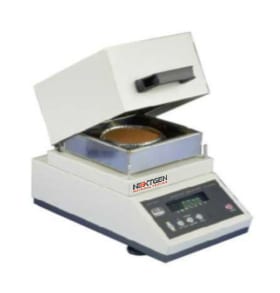
Moisture Determination Balance - GenMoist
GenMoist is designed to automatically and simultaneously dry and weight a solid sample for the determination of moisture content. The machine provides a continuous direct readout for both the weight and the percentage moisture loss through the entire cycle. It has a build-in timer.
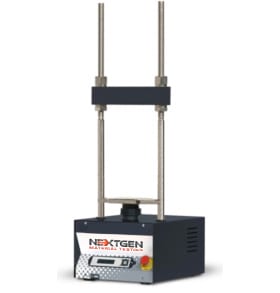
MULTISPEED Digital Automatic Universal Tester for Displacement Controlled Tests
The new MULTISPEED tester is the ideal solution for Road testing laboratory. The 50 kN capacity and the fully variable test speed of 0.2 to 51 mm/min make it possible to perform not only the CBR and Marshall tests, but many other applications as for instance Indirect Tensile test, Quick Triaxial tests, Unconfined and Uniaxial soil testing and, in general, all test to be performed under displacement control. The machine can be equipped with analogical or digital load/displacement measurement systems as well as with the specific accessories, to suit either the field or central laboratory requirement.
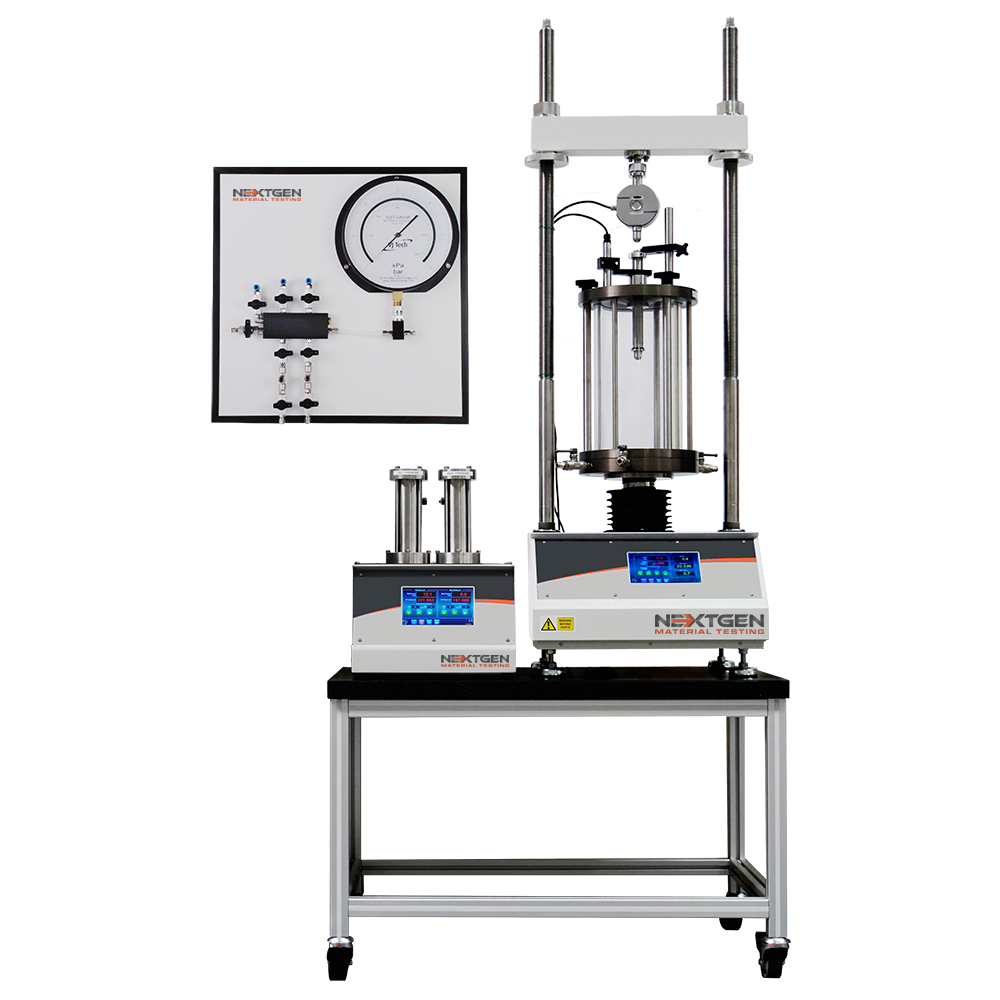
Automatic Triaxial Testing System
Automatic Triaxial Testing System for soil mechanics laboratory testing in compliance with the latest industry standards.
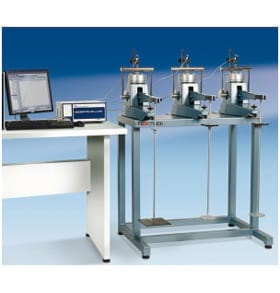
NG-Oedometer - Front Loading Oedometers - Consolidation Test
This test determines the rate and magnitude of consolidation of a soil specimen restrained laterally and subjected to a number of successive increments of vertical loads.

ACE - Automatic Computerized Oedometer
ACE - is the most advanced automatic computerized oedometer for testing soil consolidation that can measure the response of soil specimens.
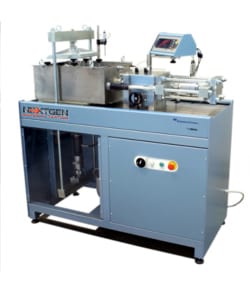
Shearmatic 300 - Large Shear Testing Machine
The SHEARMATIC 300 automatic machine is ideal for testing geosyntetics and also soil and other materials that contain large particles of up to 20 mm largest dimension. Sample size up to 300 mm square can be tested, with inserts allowing the testing of smaller sample sizes. See accessories.
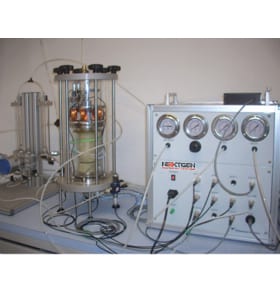
Resonant Column and Torsional Shear Tester
RESONANT COLUMN combines the features of both resonant column and torsional shear into a single unit including the current driven motor to apply torsional load to sample, a series of transducers with signal conditioning, a cell and back pressure electro-pneumatic control system and a data logger.
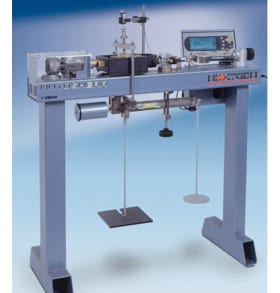
Automatic Shear Testing Machine
The microprocessor control system, therefore, allows the machine to work as an automatic stand-alone unit: the test measurements (force and displacements) a re directly displayed and stored in memory according to pre-set recording modes. The PC is only temporary required to download the test data via the RS 232 port once the test is completed. The data can be processed by the Direct and residual shear Geo-Analysis templates. See accessories.
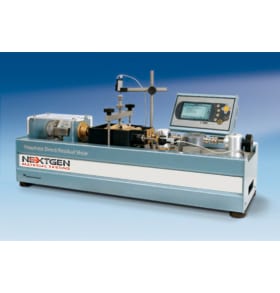
Shearmatic - Automatic Shear Testing Machine
This microprocessor based advanced model, is a stand-alone machine, driven by a high-resolution stepper motor with epicyclical reduction gear with reduced backlash. Incorporate a pneumatic closed loop system for the automatic application of the axial pressure by a high performance pressure regulator, with the main advantage of eliminating the manual loading of the dead weights. Excellent and high resistance techno-polymeric material has been adopted for the carriage of the shear box. It offers excellent resistance to corrosion, wear and tear and is resistant to all chemicals found in a soil specimen. The carriage is lightweight and easy to clean.
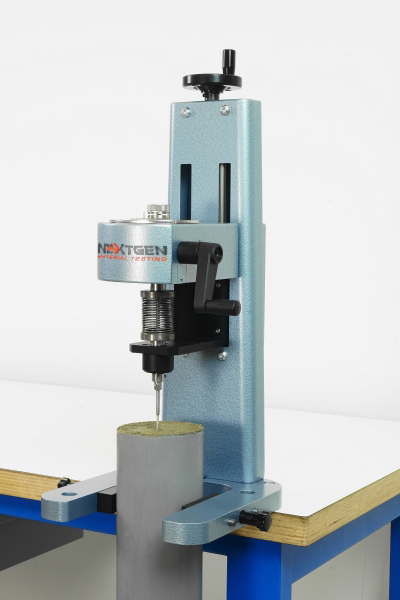
Laboratory Vane Apparatus
The laboratory vane apparatus is based on an original concept of the Transport and Road Research Laboratory of the United Kingdom. It offers versatility with a variety of vane sizes available. Typically it comes with the standard 12.7 mm square vane along with a set of four calibrated springs. Testing can be conducted either directly on the sample or within the sampling tube. For the latter, the NG-WF1738 Attachment for 38 and 100 mm diameter sampling tubes is recommended for optimal performance.
